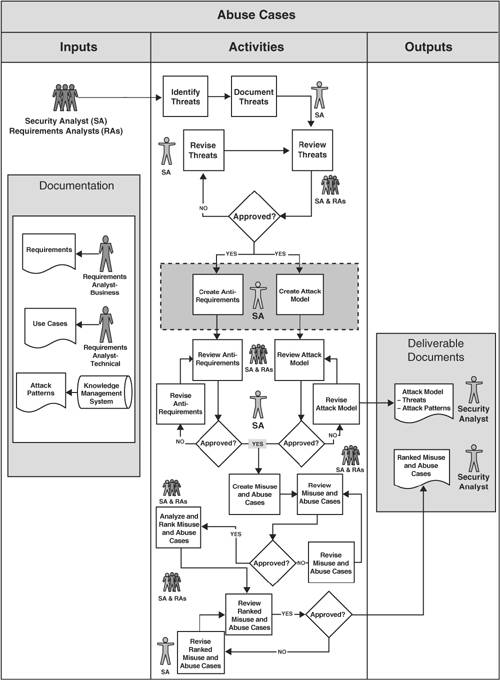This is a review of the second part of the Software Security: Building Security in book.
Chapter 3: Introduction to Software Security Touchpoints
This is an introductory chapter for the second part of the book. A very brief description is made for every security touch point.
Each one of the touchpoints are applied on a specific artifact and each touchpoints represents either a destructive or constructive activity. Based on the author experience, the ideal order based on effectiveness in which the touch points should be implemented is the following one:
- Code Review (Tools). Artifact: code. Constructive activity.
- Architectural Risk Analysis. Artifact: design and specification. Constructive activity.
- Penetration Testing. Artifact: system in its environment. Destructive activity
- Risk-Based Security Testing. Artifact system. Mix between destructive and constructive activities
- Abuse Cases. Artifact: requirements and use cases. Predominant destructive activity.
- Security Requirements. Artifact: requirements. Constructive activity.
- Security Operations. Artifact: fielded system. Constructive activity.
Another idea to mention that is worth mentioning is that the author propose to add the securty aspects as soon as possible in the software development cycle;moving left as much as possible (see the next figure that pictures the applicability of the touchpoints in the development cycle); for example it’s much better to integrate security in the requirements or architecture and design (using the risk analysis and abuse cases touchpoints) rather than waiting for the penetration testing to find the problems.

Chapter 4: Code review with a tool
For the author the code review is essential in finding security problems early in the process. The tools (the static analysis tools) can help the user to make a better job, but the user should also try to understand the output from the tool; it’s very important to not just expect that the tool will find all the security problems with no further analysis.
In the chapter a few tools (commercial or not) are named, like CQual, xg++, BOON, RATS, Fortify (which have his own paragraph) but the most important part is the list of key characteristics that a good analysis tool should have and some of the characteristics to avoid.
The key characteristics of a static analysis tool:
- be designed for security
- support multi tiers architecture
- be extensible
- be useful for security analysts and developers
- support existing development processes
The key characteristics of a static analysis tool to avoid:
- too many false positives
- spotty integration with the IDE
- single-minded support for C language
Chapter 5: Architectural Risk Analysis
Around 50% of the security problems are the result of design flows, so performing an architecture risk analysis at design level is an important part of a solid software security program.
In the beginning of the chapter the author present very briefly some existing security risk analysis methodologies: STRIDE (Microsoft), OCTAVE (Operational Critical Threat, Asset and Vulnerability Evaluation), COBIT (Control Objectives for Information and Related Technologies).
Two things are very important for the author; the ara (architectural risk analysis) must be integrated in and with the Risk Management Framework (presented briefly in Book review: Software Security: Building Security in – Part I: Software Security Fundamentals), and we must have a “forest-level” view of the system.
In the last part of the chapter the author present the Cigital way of making architectural risk analysis. The process has 3 steps:
- attack resistance analysis – have as goal to define how the system should behave against known attacks.
- ambiguity analysis – have as goal to discover new types of attacks or risks, so it relies heavily on the experience of the persons performing the analysis.
- weakness analysis – have as goal to understand end asses the impact of external software dependencies.

Chapter 6: Software Penetration Testing
The chapter starts by presenting how the penetration testing is done today. For the author, the penetration tests are misused and are used as a “feel-good exercise in pretend security”. The main problem is that the penetration tests results cannot guarantee that the system is secured after all the found vulnerabilities had been fixed and the findings are treated as a final list of issues to be fixed.
So, for the author the penetration tests are best suited to probing (live like) configuration problems and other environmental factors that deeply impact software security. Another idea is to use the architectural risk analysis as a driver for the penetration tests (the risk analysis could point to more weak part(s) of the system, or can give some attack angles). Another idea, is to treat the findings as a representative sample of faults in the system and all the findings should be incorporated back into the development cycle.
Chapter 7: Risk-Based Security Testing
Security testing should start as the feature or component/unit level and (as the penetration testing) should use the items from the architectural risk analysis to identify risks. Also the security testing should continue at system level and should be directed at properties of the integrated software system. Basically all the tests types that exist today (unit tests, integration tests) should also have a security component and a security mindset applied.
The security testing should involve two approaches:
- functional security testing: testing security mechanism to ensure that their functionality is properly implemented (kind of white hat philosophy).
- adversarial security testing: tests that are simulating the attacker’s approach (kind of black hat philosophy).
For the author the penetration tests represents a outside->in type of approach, the security testing represents an inside->out approach focusing on the software products “guts”.
Chapter 8: Abuse Case Development
The abuse case development is done in the requirements phase and it is intimately linked to the requirements and use cases. The basic idea is that as we define requirements that suppose to express how the system should behave under a correct usage, we should also define how the system should behave if it’s abused.
This is the process that is proposed by the author to build abuse cases.

The abuse cases are creating using two sources, the anti-requirements (things that you don’t want your software to do) and attack models, which are known attacks or attack types that can apply to your system. Once they are done, the abuse cases can be used as entry point for security testing and especially for the architectural risk analysis.
Chapter 9: Software Security Meets Security Operations
The main idea is that the security operations peoples and software developers should work together and each category can (and should) learn from the other (category).
The security operation peoples have the security mindset and can use this mindset and their experience in some of the touchpoints presented previously; mainly abuse cased, security testing, architectural risk analysis and penetration testing.
You must be logged in to post a comment.